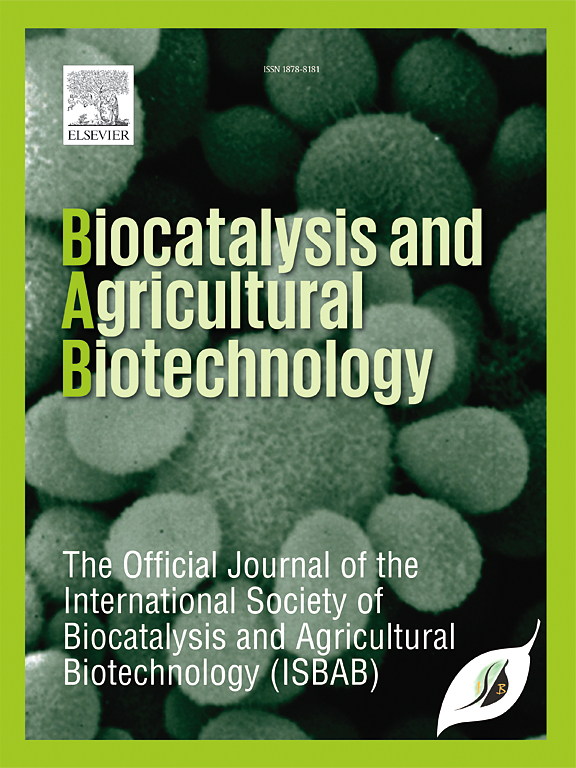Molecular characterization and molecular docking of xylanase produced by novel species Bacillus aryabhattai isolated from mangrove soil and its biodegradation efficiency
IF 3.4
Q2 BIOTECHNOLOGY & APPLIED MICROBIOLOGY
引用次数: 0
Abstract
Xylanase-producing bacteria play a crucial role in the degradation of lignocellulosic biomass, facilitating the breakdown of xylan into xylooligosaccharides and xylose. This study aimed to isolate and characterize xylanase-producing bacteria from mangrove ecosystems in Cuddalore and Pondicherry, India. A total of 22 bacterial isolates were obtained, out of which five (PMS1, PMS8, PYMW, SBMS4, and SBW1) exhibited significant xylanolytic activity. Molecular characterization using 16S rRNA sequencing identified these isolates as belonging to the Bacillus genus, with Bacillus aryabhattai (PYMW) and Bacillus subtilis (PMS8) demonstrating the highest xylanase activity. Optimization studies revealed that enzyme production peaked at pH 8.0, with maltose and glucose serving as the most effective carbon sources, and yeast extract enhancing enzyme yield (4.1 ± 0.2 U/mL) and (3.2 ± 0.2 U/mL) respectively. The xylanase enzyme was purified using ammonium sulfate precipitation, yielding a molecular weight of 50 kDa as confirmed by SDS-PAGE. Further, immobilization using sodium alginate beads enhanced enzyme stability and reusability, making it a viable candidate for industrial applications. Molecular docking studies provided insights into enzyme-substrate interactions, highlighting key residues involved in xylan degradation. These findings underscore the potential of mangrove-derived Bacillus strains as sustainable sources of xylanase for applications in bioethanol production, paper manufacturing, and waste management. Future research should focus on large-scale production, genetic modifications for enhanced efficiency, and industrial applications of immobilized xylanase.

红树林土壤中新型芽孢杆菌产木聚糖酶的分子表征、分子对接及其生物降解效率
产木聚糖酶的细菌在木质纤维素生物质的降解中起着至关重要的作用,促进木聚糖分解成低聚木糖和木糖。本研究旨在从印度Cuddalore和Pondicherry红树林生态系统中分离和鉴定产木聚糖酶细菌。共分离得到22株菌株,其中5株(PMS1、PMS8、PYMW、SBMS4和SBW1)表现出显著的木聚糖水解活性。通过16S rRNA测序鉴定这些菌株属于芽孢杆菌属,其中aryabhattai芽孢杆菌(PYMW)和枯草芽孢杆菌(PMS8)表现出最高的木聚糖酶活性。优化研究表明,酶产率在pH 8.0时达到峰值,麦芽糖和葡萄糖是最有效的碳源,酵母提取物分别提高了酶产率(4.1±0.2 U/mL)和(3.2±0.2 U/mL)。用硫酸铵沉淀法纯化木聚糖酶,SDS-PAGE证实其分子量为50 kDa。此外,海藻酸钠珠的固定化增强了酶的稳定性和可重复使用性,使其成为工业应用的可行候选者。分子对接研究提供了对酶-底物相互作用的见解,突出了木聚糖降解的关键残基。这些发现强调了源自红树林的芽孢杆菌菌株作为木聚糖酶可持续来源的潜力,可用于生物乙醇生产、造纸和废物管理。今后的研究应集中在固定化木聚糖酶的规模化生产、提高效率的基因改造和工业应用等方面。
本文章由计算机程序翻译,如有差异,请以英文原文为准。
求助全文
约1分钟内获得全文
求助全文
来源期刊

Biocatalysis and agricultural biotechnology
Agricultural and Biological Sciences-Agronomy and Crop Science
CiteScore
7.70
自引率
2.50%
发文量
308
审稿时长
48 days
期刊介绍:
Biocatalysis and Agricultural Biotechnology is the official journal of the International Society of Biocatalysis and Agricultural Biotechnology (ISBAB). The journal publishes high quality articles especially in the science and technology of biocatalysis, bioprocesses, agricultural biotechnology, biomedical biotechnology, and, if appropriate, from other related areas of biotechnology. The journal will publish peer-reviewed basic and applied research papers, authoritative reviews, and feature articles. The scope of the journal encompasses the research, industrial, and commercial aspects of biotechnology, including the areas of: biocatalysis; bioprocesses; food and agriculture; genetic engineering; molecular biology; healthcare and pharmaceuticals; biofuels; genomics; nanotechnology; environment and biodiversity; and bioremediation.
 求助内容:
求助内容: 应助结果提醒方式:
应助结果提醒方式:


